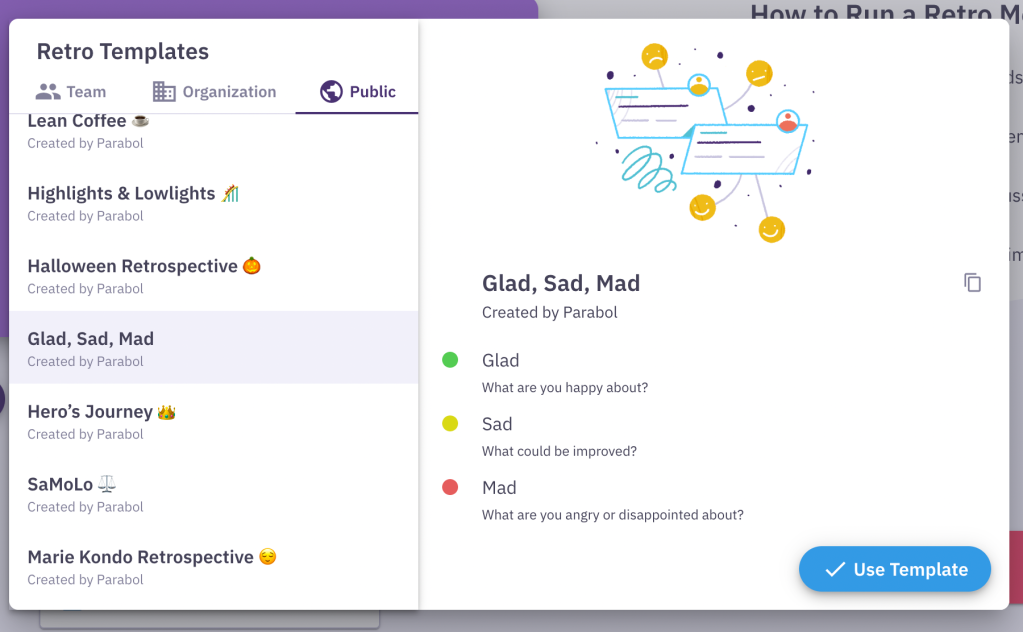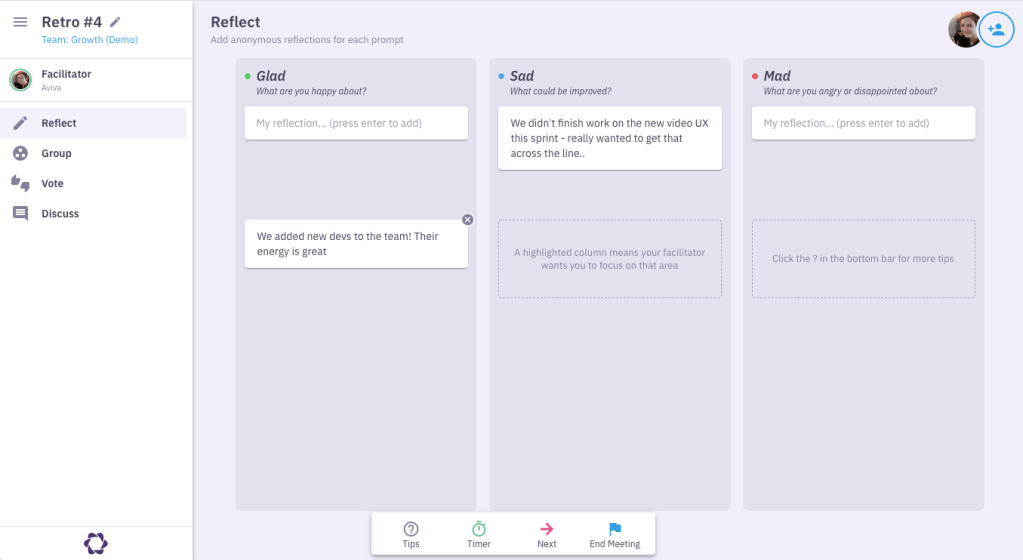Mad Sad Glad Retrospective
Focus on feelings with this simple retrospective technique

What is a Mad Sad Glad retrospective?
A Mad Sad Glad retro is a classic retrospective technique that can help teams discover tensions in the way they work. Running one of these retrospective meetings will help you locate where the stress of team members is creating rough patches in your process.
This retrospective can help you:
- Establish healthy team dynamics
- Improve team morale
- Refine processes so they work as well in practice as they do on paper
What are the Mad Sad Glad retro prompts?
Remember, the focus is on feelings when running a Mad Sad Glad retrospective, and all feelings are on the table and valid. Let’s look at each category and define the feelings you’re looking for with this retrospective template.
Mad 😡
What drove you crazy? Did you hit any roadblocks that tanked productivity? What parts were a huge hassle? These are the things you didn’t like, even if they seemed to work.
Example: I can’t stand filling out that time allocation sheet every week!
Sad 😞
What experiences disappointed you? What do you wish could be improved? Things in this column aren’t necessarily bad, but they’re not productive either.
Example: I wish we didn’t have to rush the UX research phase so much last sprint
Glad 😊
What parts of this process or project did you enjoy? What were the successes and wins that put a smile on your face? These are the things that make you think, “I love the way this went.”
Example: Kicking things off with a huge group brainstorming session was so fun!
Benefits of a Mad Sad Glad retrospective
The key to Mad Sad Glad retrospectives is giving space to participants to share their feelings—something that’s not easy for everyone. You’re talking about emotions, which are personal, so remind everyone the goal is to learn, not to blame, accuse, or throw anyone under the bus.
The retrospective is a safe environment to share experiences. Learning about how different team members perceive the same experience is inherently valuable.
It’s also important to remember that your goal isn’t to solve the problems brought up by the feelings in this agile retrospective. Probe them, examine them, dig deeper to find root causes, but don’t dismiss feelings with any off-the-cuff solutions.
Cultivating that safe environment will likely result in greater participation and discussion. Mad Sad Glad retrospectives will get richer over time, as team members feel more and more comfortable sharing the tensions they’re experiencing.
When should you do a Mad Sad Glad retrospective?
Run this retrospective when you want to make an impact on morale and job satisfaction.
It can also be a handy way of discovering different perspectives among the team and help to create a positive team atmosphere.
Here are a few scenarios where a Glad Sad Mad retro could come in handy:
During a change in team dynamics
Maybe you brought on several new team members in the previous sprint after a company acquisition, or maybe you’ve got a new scrum master who brought in new processes and ideas. Changing a team’s dynamics can create new tension points, use this retro to find them.
After an event
Maybe you brought on several new team members in the previous sprint after a company acquisition, or maybe you’ve got a new scrum master who brought in new processes and ideas. Changing a team’s dynamics can create new tension points, use this retro to find them.
When adopting new software or process
Bringing everyone onto new software or a company-wide process can be bumpy, especially if the old programs were deeply entrenched. Running one of these retros after everyone has had a chance to adjust could help you address the emotional issues that inevitably pop up when change is forced on a team.
To focus on feelings
These are far from the only scenarios! It’s a great option any time you want to assess the feelings of a team. You can run one just to break up the normal everyday business of work, or to find ways to help employees emotionally invest in the company, a project or process.
📌 Remember: This retrospective technique focuses on Mad, Sad, and Glad! Not just the first two. So remember to focus on what went well too. Then you can double down on those behaviors for the next sprint.
How to run a Mad Sad Glad retrospective with Parabol
From your dashboard select your team on the right and then hit that vibrant Add Meeting button.
Select Retro Meeting with the arrows, then use the dropdown to select the Mad Sad Glad retro template.

Start your retro with an icebreaker
The Icebreaker box is checked on by default. You don’t have to do one, but we recommend it. They offer a chance to break the ice, set a positive team mood, and get everyone ready to contribute.
If you’re doing an icebreaker, you’ll have a random question to answer. You can refresh it if you want another option, and of course you can create your own if you want.

Reflect, group, and discuss based on the Mad Sad Glad prompts
After the icebreaker the facilitator will move on to the reflect stage. This is where you get into the principles of the Mad Sad Glad retro discussed above. Think about you’re glad, sad, and mad about and write them on Parabol’s digital sticky notes.

Parabol is remote-friendly, enabling you to work asynchronously with your team. They can all leave comments together, or do it at a time that works for them.
Also, reflections are anonymous, and no one can see them until you’re done working on them.
After the reflect phase, you’ll vote on issues to discuss, talk about the most voted on items, and then get a summary of the retro when you’re done. Make sure to review the retro 101 guide for tips on having a stand-out retro with Parabol.